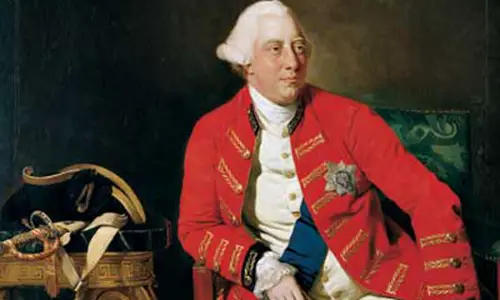• King George’s Illness
King George III had said to be infected by a genetic disease called porphyria, which was also been suffered by Mary Queen of Scots and her son. The first attack of the disease happened four years after his marriage to Queen Charlotte (1765). King George was infected badly that he loses his sight and became insane during the worst state of the disease and until his death on January 29, 1820 at the Windsor Castle.
• George William Frederick
George William Frederick, also known as King George III, is the eldest son of the King of Wales, Frederick Louis, and the princess of Saxe-Gotha, Augusta. King George III was born in London, England on June 4, 1739.
• King George III
King George III became heir to the throne on his father’s death, dated in 1751. He succeeded the throne in1760 from his grandfather, King George II. King George III was the third Hanoverian King of Great Britain, the first king to use English as his first language, and also the first one to be born in England.
• 1760 to 1820
King George III was the King of Britain for over 6 great decades, making it the 2nd longest in the British history. He got the throne from his grandfather (King George II) in 1760 and left the throne to his eldest son (King George IV) in his death on January 29, 1820.
• King George III’s Family
King George III chose Charlotte Sophia of Mecklenburg-Strelitz as his wife among other eligible German princesses. They were married on September 8, 1761 that lasted for more than 50 years. They had 15 children including 9 boys and 6 girls. The successor of the throne is the oldest of their children.
• Hair Examination
The hair of King George III was examined by scientist if it was exposed to heavy metals. The lock of hair was given by The Wellcome Trust and Science Museum in London and was kept in a black-edged envelope without any preservatives. Scientists found minimal exposures for lead and mercury but shows a high percentage of Arsenic, which may worsen the symptoms of porphyria.
• Royal Marriages Act of 1772
King George III’s family disappointed him, especially his sons and brother. His brother made unsuitable secret marriages that lead to the Royal Marriage Act of 1772 under the effort of King George III. Under this law, those who are descendant of King George II must give consent before marrying, with certain exceptions.
• The Madness of King George
The Madness of King George was a film about King George III’s life directed by Nicholas Hytner. The film won the 1994 Academy Award for Best Art Direction with Nigel Hawthorne’s nomination for Best Actor for his leading role and Helen Mirren’s nomination for Best Actress for her supporting role.
• The Royal Collection
King George III was one of the most cultured of monarchs. He had a royal collection of books which opens to scholars. Over 65,000 of his books were given to the British Museum as the nucleus of national library. He was also the first king to study science with a collection of scientific instruments that can now be seen in the Science Museum located in London, United Kingdom.
• Arsenic Poisoning
Some new studies stated that arsenic poisoning can also be one reason for King George III’s death. King George III suffered abdominal and limb pain, insomnia, anxiety, confusion, and irritability during his sovereignty. Although, historians said that he had porphyria, the symptoms also shown signs of exposure to heavy metals.











Leave a Reply